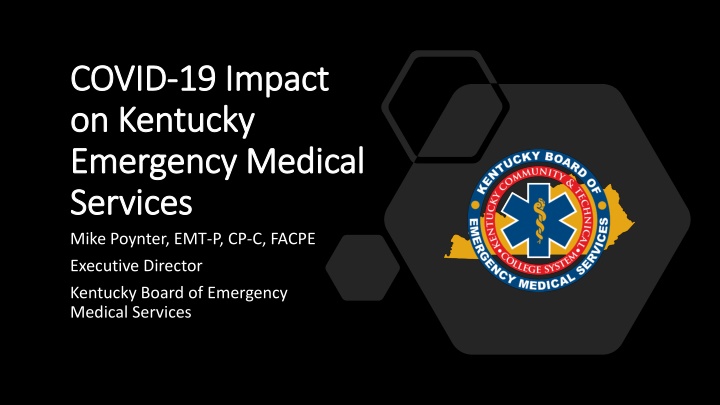
Impact of COVID-19 on Kentucky Emergency Medical Services
Explore the impact of COVID-19 on Kentucky Emergency Medical Services, including statistics on certified providers, call volumes, financial impacts, and government funding challenges. Learn how agencies are adapting and responding to the ongoing pandemic.
Download Presentation

Please find below an Image/Link to download the presentation.
The content on the website is provided AS IS for your information and personal use only. It may not be sold, licensed, or shared on other websites without obtaining consent from the author. If you encounter any issues during the download, it is possible that the publisher has removed the file from their server.
You are allowed to download the files provided on this website for personal or commercial use, subject to the condition that they are used lawfully. All files are the property of their respective owners.
The content on the website is provided AS IS for your information and personal use only. It may not be sold, licensed, or shared on other websites without obtaining consent from the author.
E N D
Presentation Transcript
COVID COVID- -19 Impact 19 Impact on Kentucky on Kentucky Emergency Medical Emergency Medical Services Services Mike Poynter, EMT-P, CP-C, FACPE Executive Director Kentucky Board of Emergency Medical Services
14,816 Certified and Licensed EMS providers 571 Emergency Medical Responders (EMR) 9,705 Emergency Medical Technicians (EMT) 402 Advanced Emergency Medical Technicians (AEMT) Personnel and Assets 4,138 Paramedics (EMTP) 220 Licensed EMS Agencies 1,090 Ambulances 5 Fixed Wing Aircraft (Airplane) 81 Rotor Wing (Helicopter)
40% Public, 34% 35% 30% Fire-Based, 28% 25% Agencies Represented Private non-profit, 18% 20% 15% Hospital-based, 10% 10% Private for-profit, 7% 5% Other, 3% 0% Public Fire-Based Private non- profit Hospital-based Private for-profit Other Public Fire-Based Private non-profit Hospital-based Private for-profit Other
800 750 700 600 COVID-19 Emergency Provider Reinstatements (Free) 500 400 300 200 155 103 100 4 0 EMR EMT AEMT Paramedic
40% 38% 35% 30% 28% 25% Financial Impact 20% 17% 15% 11% 10% 6% 5% 0% Significant Positive Some Positive Status Quo Some Negative Significant Negative Significant Positive Some Positive Status Quo Some Negative Significant Negative
Apr. 2020 In April 2020, over 50% of responding agencies reported that they had applied for federal, state, or local funding but were denied. Government Funding In April 2021, Respondents reported an improvement in receiving funding. However, responses indicate that less than half of all agencies applying are receiving government support. Apr. 2021
EMS Personnel Report Average Number of EMS Personnel in Isolation or Quarantine Per Week 250 201 200 150 116 94 90 100 70 63 41 40 50 36 35 27 25 14 6 0 3/20 4/20 5/20 6/20 7/20 8/20 9/20 10/20 11/20 12/20 1/21 2/21 3/21 4/21 3/20 4/20 5/20 6/20 7/20 8/20 9/20 10/20 11/20 12/20 1/21 2/21 3/21 4/21
~ 1,716 of the KY EMS workforce have had to quarantine or be in isolation at some time during the pandemic Impact to the EMS Workforce
45% 41% 40% 35% 31% 30% 26% 25% Offload Times 20% 15% 10% 5% 1% 1% 0% Increased Significantly Increased Slightly Status Quo Decreased Slightly Decreased Significantly Increased Significantly Increased Slightly Status Quo Decreased Slightly Decreased Significantly
90% 80% 77% 77% 70% 61% 59% 60% 57% 50% Stakeholder Engagement 42% 40% 30% 20% 10% 0% Local Healthcare System Local Public Health Agency Regional Healthcare Coalition Engaged April 2021 Engaged April 2020
Summary Much of the EMS workforce are operating with high levels of stress, fatigue and burnout. Financial challenges continue to plague EMS across all delivery models; rural EMS is in a crisis. The federal government should review the cost of the emergent, urgent and preventive care provided by EMS, and include reimbursement for treatment in place, transport to alternate designations, telemedicine facilitation, and community paramedicine.






















